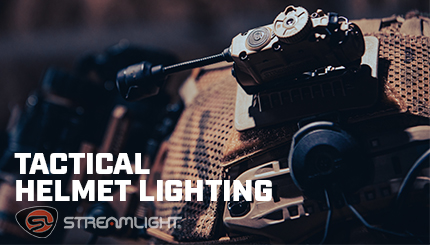Community Blogs Detail
Tactical Helmet Lighting
By Brian Osborn, Regional Sales Manager

Some years back while I was still working on SWAT and as an LE firearms instructor, I reviewed film of some officers that had missed a suspect on an initial search of a house. The officers hadn’t seen the suspect hiding behind a hot water tank. They missed him again on a secondary search as well. It made me think about the roles that Law Enforcement Officers members of our Armed Services have when searching a structure and what tools are necessary to complete those jobs safely. The search tactics of the officers were to blame for missing the suspect, not the tools. But what tools are needed to conduct the search properly and supplement the tactics?
Hand-held and weapon-mounted lights come into play during the first step when searching a structure. Great leaps in technology have put 1,000-2,000 lumens of light into the hands and onto the weapons of officers and soldiers. But what happens when the structure is clear of threats and the next phase of the search begins? This phase focuses on gathering intelligence or items of evidentiary value. That’s where helmet lights can be of great assistance. There are many different functions to Streamlight’s Sidewinder Stalk® that make it more than just a white light. The Sidewinder Stalk® has an adjustable head that can flex and be pointed where you need the light. The main head has selectable light outputs in three different intensities of white, red, blue, green and IR for use with night vision goggles (NVG’s). In addition to the main head outputs, the Sidewinder Stalk® has an IR/IFF light on top that strobes at 50bpm. The IFF (Identify Friend or Foe) strobe also has a lockout mode to prevent accidental activation. Let’s talk a little bit about how each of these functions can be used.
Starting with the white light – this would be the most obvious choice for after a primary search is completed, and you’ve moved onto that intel- or evidence-gathering stage. The white light is also valuable when providing first aid to someone who has been injured if the environment is safe to use white light. Most officers carry tourniquets and first aid kits now, but it’s hard to apply those and use both hands unless you have a helmet light to see what you’re doing. The color mode in the Sidewinder Stalk® offers the user the choice between red, green, or blue light output. Red has traditionally been a good low-power light for reading maps or anything else you want to see without ruining your natural night vision. Your eyes adapt back to the dark better after using red light and it’s harder for someone else to see red light from a distance.
Green has become more popular in the aviation world, as it is easier to read things in low light compared to red. Although it’s simpler for an adversary to see the brighter green light from a distance, it’s still more difficult to see than white, and green offers some of the benefits of retaining your natural night vision like red does when you turn the light off. Green has become my personal favorite to work with in low light because of the ease of reading things and it won’t affect your partners NVG’s like white light can.
The blue light output of the Sidewinder Stalk® makes it easier to perform a “buddy check” after they may have been injured. The blue can contrast with the red color of blood to make it easier to detect, without the side effects of white light, which can give away your position more easily or reduce your natural night vision.
The IR output mode on the Stalk is valuable to anyone wearing night vision goggles in an extremely dark environment. NVG’s amplify available light and many today are so efficient that almost no natural light is needed. Even a small LED on a charger or the illuminated numbers on a clock can be enough to light up a room for someone wearing NVG’s. But I have been in situations where there was no available light to amplify, and IR illumination was necessary. With the Sidewinder Stalk®, the IR light can be aimed directly ahead, where you’re looking, or it can be pointed up at the ceiling of a room and be bounced or “umbrellaed” across the whole room. As mentioned earlier, the Stalk also has an IR/IFF strobe on top of the light. This is valuable for LE and military units that are working under NVG’s so that they can easily identify each other from the ground or from the air. I’ve used these IR strobes in the past to mark specific teammates during training. This allowed them to be identified on IR cameras while in a live fire shoot house so that they could be identified later when evaluating their performance on film.
The Sidewinder Stalk® can mount to helmets and onto MOLLE in a variety of ways. In addition to a clamp mount that works on most helmets, the ARC rail mount also allows for a low-profile mount for compatible systems or a Velcro mount plate to attach to Velcro panels. More and more items are being added to helmets and weapons platforms to provide an advantage to the user. The Sidewinder Stalk® replaces multiple tools from the head and condenses them into one small lightweight device that can run on either CR123A or AA alkaline and lithium cells. In a world that demands more of our officers and military members every day, they should be equipped with the right tools to enhance their tactics and performance.

